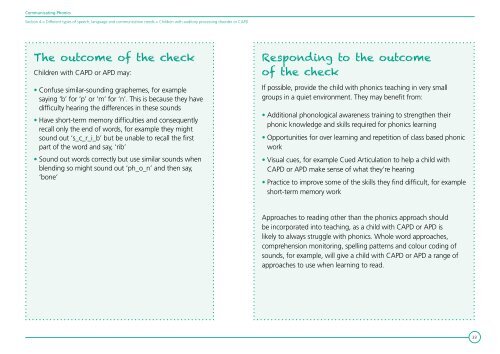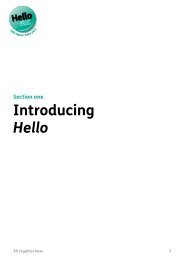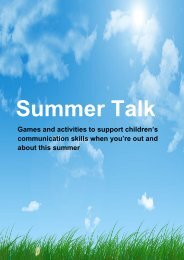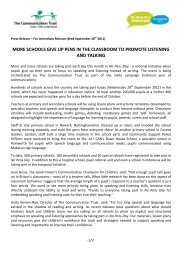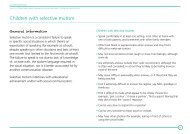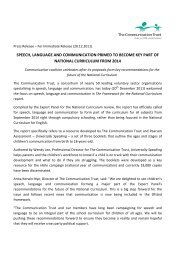Communicating Phonics - The Communication Trust
Communicating Phonics - The Communication Trust
Communicating Phonics - The Communication Trust
You also want an ePaper? Increase the reach of your titles
YUMPU automatically turns print PDFs into web optimized ePapers that Google loves.
<strong>Communicating</strong> <strong>Phonics</strong>Section 4 > Different types of speech, language and communication needs > Children with auditory processing disorder or CAPD<strong>The</strong> outcome of the checkChildren with CAPD or APD may:• Confuse similar-sounding graphemes, for examplesaying ‘b’ for ‘p’ or ‘m’ for ‘n’. This is because they havedifficulty hearing the differences in these sounds• Have short-term memory difficulties and consequentlyrecall only the end of words, for example they mightsound out ‘s_c_r_i_b’ but be unable to recall the firstpart of the word and say, ‘rib’• Sound out words correctly but use similar sounds whenblending so might sound out ‘ph_o_n’ and then say,‘bone’Responding to the outcomeof the checkIf possible, provide the child with phonics teaching in very smallgroups in a quiet environment. <strong>The</strong>y may benefit from:• Additional phonological awareness training to strengthen theirphonic knowledge and skills required for phonics learning• Opportunities for over learning and repetition of class based phonicwork• Visual cues, for example Cued Articulation to help a child withCAPD or APD make sense of what they’re hearing• Practice to improve some of the skills they find difficult, for exampleshort-term memory workApproaches to reading other than the phonics approach shouldbe incorporated into teaching, as a child with CAPD or APD islikely to always struggle with phonics. Whole word approaches,comprehension monitoring, spelling patterns and colour coding ofsounds, for example, will give a child with CAPD or APD a range ofapproaches to use when learning to read.33


